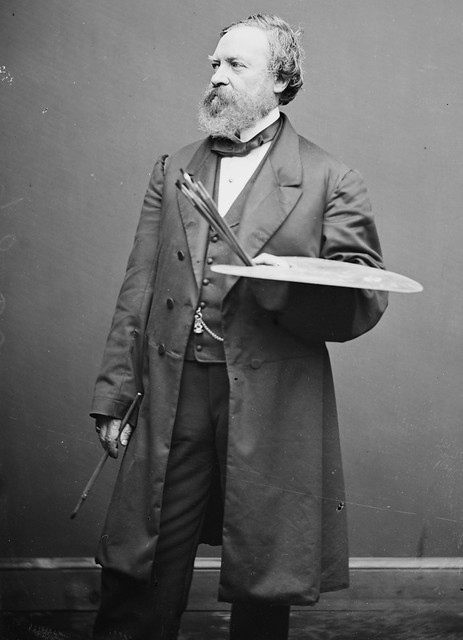Brumidi was half Roman, so we conisder that at least an honorary Cisalpine; and in our opinion, a Padanian-American. Modern Romans are northern in character. It's surprising that there isn't much information out there on him, considering that his craftmanship is still very much featured in the U.S. capitol building. Here is a sample of that artwork. It appears--to put it bluntly--like any situation where someone was contracted to do a job, did it very well, and was forgotten about.
June 10, 2008: Rep. Ackerman manages legislation on the House floor to posthumously award Constantino Brumidi, the Artist of the Capitol, with a Congressional Gold Medal.
Constantino Brumidi (from Wikipedia)
Constantino Brumidi (July 26, 1805 – February 19, 1880) was a Greek/Italian-American historical painter, best known and honored for his fresco work in the Capitol Building in Washington, DC.
Parentage and early life
Brumidi was born in Rome, his father a Greek from Filiatra in the province of Messinia, Greece, and his mother an Italian. He showed his talent for fresco painting at an early age and painted in several Roman palaces, among them being that of Prince Torlonia. Under Gregory XVI he worked for three years in the Vatican.
Emigration and following work
The occupation of Rome by French forces in 1849 apparently persuaded Brumidi to emigrate, having joined the short-lived risorgimental Roman Republic, and he sailed for the United States, where he became a naturalized citizen in 1852. Taking up his residence in New York City, the artist painted a number of portraits. Subsequently he undertook more important works, the principal being a fresco of the Crucifixion in St. Stephen's Church, for which he also executed a Martyrdom of St. Stephen and an Assumption of Mary. He also executed frescoes at Taylor's Chapel, Baltimore, Maryland.
In 1854 Brumidi went to Mexico, where he painted an allegorical representation of the Holy Trinity in the Mexico City cathedral. On his way back to New York he stopped at Washington D.C. and visited the Capitol. Impressed with the opportunity for decoration presented by its vast interior wall spaces, he offered his services for that purpose to Quartermaster General Montgomery C. Meigs. This offer was accepted, and about the same time he was commissioned as a captain of cavalry.
His first art work in the Capitol Building was in the meeting room of the House Committee on Agriculture. At first he received eight dollars a day, which Jefferson Davis, then Secretary of War of the United States, helped increase to ten dollars. His work attracting much favourable attention, he was given further commissions, and gradually settled into the position of a Government painter. His chief work in Washington was done in the rotunda of the Capitol and included the Apotheosis of George Washington in the dome and the Frieze of American History, which contains allegorical scenes from American history. His work in the rotunda was left unfinished at his death, but he had decorated many other sections of the building, most notably hallways in the Senate side of the Capitol now known as the Brumidi Corridors.
In the Cathedral-Basilica of Sts. Peter and Paul in Philadelphia, Pennsylvania, he pictured St. Peter and St. Paul. Brumidi was a capable, if conventional painter, and his black and white modeling in the work at Washington, in imitation of bas-relief, is strikingly effective. He decorated the entrance hall of Saleaudo, located at Frederick, Maryland, and listed on the National Register of Historic Places in 1979.
He died in Washington, DC.
Forgotten for many years, Brumidi's role was rescued from obscurity by Myrtle Cheney Murdock.
.


